5+ Sample Nonprofit Board Meeting Agenda
-

Sample Nonprofit Board Meeting Agenda
download now -
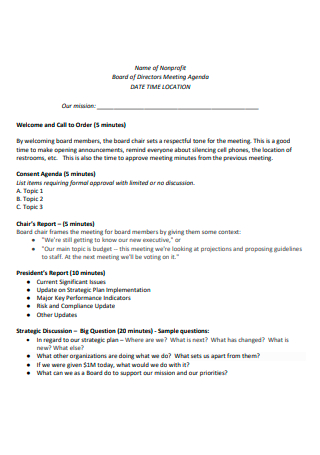
Nonprofit Board of Directors Meeting Agenda
download now -
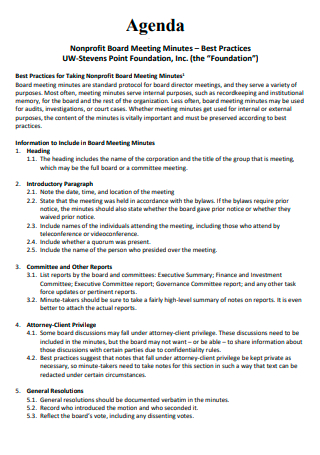
Nonprofit Board Meeting Minutes Agenda
download now -
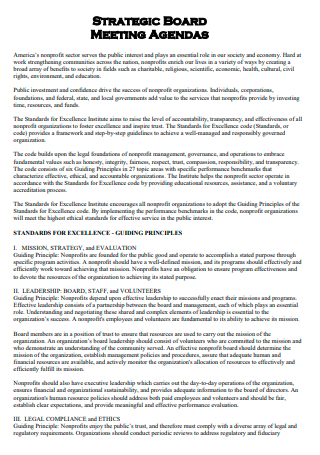
Nonprofit Strategic Board Meeting Agenda
download now -
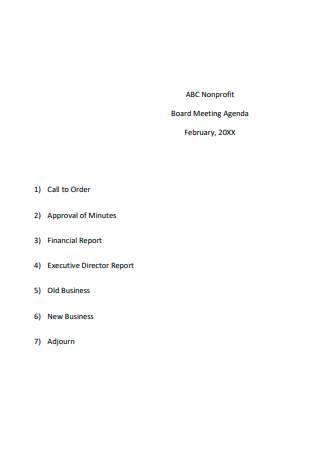
Simple Nonprofit Board Meeting Agenda
download now -
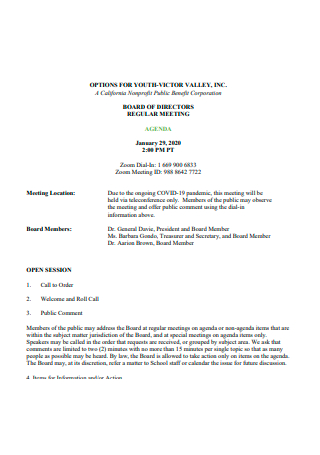
Nonprofit Public Board of Directors Regular Meeting Agenda
download now
What Is a Nonprofit Board Meeting Agenda?
An agenda for a board or staff meeting of a nonprofit organization serves as a road map. The plan contains information about fundraising, finances, programs, nominations, and other pertinent matters. It is essential to maintain the meeting’s structure and order, and the secretary utilizes it to summarize the meeting minutes. Statistics indicate that just 11% of appointments are effective, although corporations devote approximately 15% of their time.
Benefits of Paperless Board Meetings
One of the essential advantages of paperless board meetings is reducing expenditures. Your firm can save a substantial amount of money annually if the requirement for paper is eliminated or significantly reduced. The other advantages of conducting a paperless board meeting are less apparent but significant. Here are the first seven:
Tips for Running an Effective Non-Profit Board Meeting
Preparing systematically for your next nonprofit board meeting reduces stress, but it can also help your nonprofit do better overall. Your nonprofit’s monthly board meetings don’t have to be boring, frustrating, and stressful. If board meetings are run well, they can help the nonprofit get closer to its goals. They can help and encourage the people on your staff. They can be worth the time you put into making plans for them. So, how do you know that your nonprofit board meetings are not being run well? Here are some suggestions you can use.
1. Prepare the agenda for the Board meeting in advance
Prepare the agenda for the board meeting of your nonprofit organization at least one month in advance, and send it along with a reminder to all board members at least seven days beforehand. Include any financial statements, reports, and other relevant papers in the email, so that your board members have ample time to review the information before the meeting. Include a copy of the budget in the email if, for example, your treasurer will discuss it. If your board chair will discuss the program’s growth, provide a graph analysis and a list of growth figures. This will boost meeting productivity by decreasing the time required to present and review information. This package must be well-organized, easy to read, and devoid of unnecessary details. Be careful to allocate time for “new business” at the end of the meeting for matters that were not on the agenda.
2. Strategically plan board meetings
Many charitable organizations take agenda creation for board meetings for granted. It is frequently viewed as merely a list of topics discussed in a meeting. At least a portion of a board meeting should be strategic. Although it is easy for a nonprofit board meeting to become a formality or a repeat of material that could have been communicated by email, there are simple ways to make your nonprofit board meeting agenda more purposeful. You might ensure that one strategic objective is reviewed at each board meeting. Otherwise, try to organize the entire schedule of your board around the strategic goals of your nonprofit organization. Changing the style of your board meeting can be challenging at times, mainly if your board members are accustomed to a more conventional arrangement. In this situation, it may be beneficial to assign one board member as the strategy accountable and remind the committee to be more strategic by asking, “How can this circumstance assist us to achieve this strategic aim more effectively?”
3. Mission-focused board meeting agenda
Achieving a mission is as vital for a nonprofit as many other issues that frequently appear on the agendas of nonprofit board meetings. To keep the plan of your nonprofit board meeting focused on the organization’s objective, write the mission statement above the agenda so that everyone is continuously reminded of it. You may also have a recipient of your organization’s assistance or a volunteer describe a typical day in the field. This helps the board maintain a connection to the mission of the organization.
4. Time your nonprofit board meeting
Board members typically have jam-packed schedules, making it increasingly simple to rationalize tardiness. This frequently leads to continually rescheduled meetings and board members coming later and later. Always begin sessions promptly! If feasible, limit the duration of meetings to two hours or fewer. If the conference is held in the evening, concentration begins to wane after two hours. If you must travel for longer than two hours, you should take a break. Refreshments are usually a welcome addition. Likewise, make sure to finish your nonprofit board meetings on schedule. This demonstrates that you value the board members’ time.
5. Focus the meeting on decisions rather than updates
The board members of your nonprofit organization are one of your most valuable assets. Your nonprofit board members should speak at least 80 percent during meetings, with most time spent on choices and strategic discussions rather than updates and staff reports. Many nonprofit organizations discover that their board meetings become so overburdened with material that there is little time for debate and decision-making on crucial topics. This distracts from talks about your nonprofit’s long-term strategic goals and how the board may contribute value. Find strategies to reduce the size of information downloads and reports. Instead, use a consent agenda to approve ordinary things such as minutes, contracts, and regulations that have been reviewed. Consent agenda items are typical or noncontroversial topics discussed at each meeting. Here you may learn more about the consent agenda.
6. Take Board Meeting Minutes
Few people like taking meeting minutes, writing them up, giving them out, or reading them. But if you do meeting minutes the right way for your nonprofit’s needs, they can be a constructive way to keep your board focused on the task at hand. The minutes of each board meeting should be sent to everyone there within 24 hours. This makes sure that everyone is clear on what needs to be done, and it shows the board members that you care. Get a copy of the meeting agenda for taking notes and writing the minutes. The order and numbering of the items on the meeting minutes should match those on the plan. Make it a habit to circle tasks and the person responsible for doing them.
7. Get a good board chair for your nonprofit
Your nonprofit board meeting agenda is the most crucial tool for conducting productive board meetings. However, a schedule can only accomplish so much. A competent nonprofit board chair is essential to the success of any board meeting. So, what are the characteristics of an effective board chair? They must have fundamental knowledge and comprehension of your organization’s governance principles. To be effective, they must also have industry experience and knowledge of your nonprofit’s operations. In addition, board chairs must possess the social and organizational abilities necessary to conduct meetings efficiently and successfully. Board chairs must have the ability to manage multiple personalities and diverse social circumstances. Ideally, they should be open and firm in facilitating the plan and ensuring that everything works smoothly and on schedule. A board chair should also guide debates with tact and acknowledge people who offer excellent proposals. It is also their responsibility to prevent one or two board members from dominating each board meeting.
How to Write an Agenda
Consider a time when an important meeting you attended went terribly. Was there an objective at its core? If you do not recall getting a plan from the meeting facilitator, it is possible that the meeting did not proceed as intended. Writing an agenda for every meeting demonstrates to your team members and other participants that you have thoroughly examined the meeting’s objective and respect their time by conveying what to expect. If you are still interested, here are the steps to creating a plan.
Step 1: Determine the meeting’s purpose
Knowing what you want (or need) from your meeting may seem easy, but it’s likely crucial. A well-defined objective informs attendees of the forum’s purpose and what you intend to achieve by convening a group of individuals in a conference room. In addition, this communicates that you value the time and work of all participants.
Step 2: Request input from your team members and be clear about the meeting
Before your meeting, it’s essential to get your team’s ideas on making it a good one for everyone there. This way, you can ensure that everything your team needs is on the list of things to talk about. This will make the meeting more effective as a whole. Also, when you’re in the middle of a forum, it can be easy to talk about other things. That’s why it’s essential to put the purpose of your meeting at the top of your plan. If you or a team member gets off track, bring the conversation back to the main point of the forum and get everyone back on track.
Step 3: Make sure team topics are relevant
When scheduling a meeting with multiple participants, ensure that the topics to be discussed are relevant to all attendees. If you wish to consult with a single team member, remove it from the plan, and schedule a 1:1 meeting if there is a particular topic. Thus, you will not waste the time of the other guests.
Step 4: Identify who will lead each session and allow questions
In certain instances, someone other than yourself or the facilitator may lead a discussion on one of the themes. If you require someone else to direct a portion of the conversation, include their name and topic on the agenda. Thus, the conference will proceed more efficiently and without confusion. Also, To keep the meeting on track and orderly, participants should refrain from asking questions or otherwise interfering. However, doing so makes it essential to provide time in the end for questions. Thus, the inevitable concerns that team members will have throughout the meeting can be addressed orderly, and the session can go as scheduled.
FAQs
What are the rules for board meetings?
Follow the plan to keep the group focused on its objectives. Allow the group to complete its tasks; do not micromanage. Control the meeting’s flow by recognizing members who request to speak. Allow everyone to speak once before allowing anyone to talk again.
How often should a board meet?
While most corporate bylaws and state regulations require that an organization’s board of directors meet at least once a year, organizations seeking direction on how often their boards should meet have considerable latitude.
What does a chairperson do before a meeting?
Before a meeting, the chairperson and secretary should discuss any topics discussed. They should both review and prepare the meeting’s agenda. They should also determine whether the committee members have received the meeting’s documents and reports.
Boards are essential. They provide supervision, influence strategy, supervise management, and protect against excessive risks and compliance violations. They may also direct programs, lead fundraising efforts, and serve as the organization’s advocates. In minor charitable organizations, the board is the organization. These are significant duties and crucial activities that must be completed accurately. The most successful organizations know how to capitalize on their board members’ skills, knowledge, and dedication. Therefore, it is essential to conduct effective board meetings. And the most crucial tool for your board is the meeting agenda. Having a set and focused plan for board meetings allows the board to maximize precision, efficiency, and output. Remember that fantastic board meetings are typically what makes boards great.